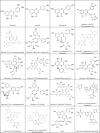Therapeutic implications of quercetin and its derived-products in COVID-19 protection and prophylactic
- PMID: 38765079
- PMCID: PMC11098804
- DOI: 10.1016/j.heliyon.2024.e30080
Therapeutic implications of quercetin and its derived-products in COVID-19 protection and prophylactic
Abstract
Severe acute respiratory syndrome coronavirus 2 (SARS-CoV-2), a novel human coronavirus, which has triggered a global pandemic of the coronavirus infectious disease 2019 (COVID-19). Outbreaks of emerging infectious diseases continue to challenge human health worldwide. The virus conquers human cells through the angiotensin-converting enzyme 2 receptor-driven pathway by mostly targeting the human respiratory tract. Quercetin is a natural flavonoid widely represented in the plant kingdom. Cumulative evidence has demonstrated that quercetin and its derivatives have various pharmacological properties including anti-cancer, anti-hypertension, anti-hyperlipidemia, anti-hyperglycemia, anti-microbial, antiviral, neuroprotective, and cardio-protective effects, because it is a potential treatment for severe inflammation and acute respiratory distress syndrome. Furthermore, it is the main life-threatening condition in patients with COVID-19. This article provides a comprehensive review of the primary literature on the predictable effectiveness of quercetin and its derivatives docked to multi-target of SARS-CoV-2 and host cells via in silico and some of validation through in vitro, in vivo, and clinically to fight SARS-CoV-2 infections, contribute to the reduction of inflammation, which suggests the preventive and therapeutic latency of quercetin and its derived-products against COVID-19 pandemic, multisystem inflammatory syndromes (MIS), and long-COVID.
Keywords: COVID-19; In silico; Long-COVID; MIS; Quercetin.
© 2024 The Author(s).
Conflict of interest statement
The authors declare that they have no known competing financial interests or personal relationships that could have appeared to influence the work reported in this paper.
Figures






Similar articles
-
Human and novel coronavirus infections in children: a review.Paediatr Int Child Health. 2021 Feb;41(1):36-55. doi: 10.1080/20469047.2020.1781356. Epub 2020 Jun 25. Paediatr Int Child Health. 2021. PMID: 32584199 Review.
-
Antiviral, immunomodulatory, and anticoagulant effects of quercetin and its derivatives: Potential role in prevention and management of COVID-19.J Pharm Anal. 2022 Feb;12(1):29-34. doi: 10.1016/j.jpha.2021.09.009. Epub 2021 Sep 20. J Pharm Anal. 2022. PMID: 34567823 Free PMC article. Review.
-
Testing the efficacy and safety of BIO101, for the prevention of respiratory deterioration, in patients with COVID-19 pneumonia (COVA study): a structured summary of a study protocol for a randomised controlled trial.Trials. 2021 Jan 11;22(1):42. doi: 10.1186/s13063-020-04998-5. Trials. 2021. PMID: 33430924 Free PMC article.
-
Molecular Docking and ADMET Prediction of Natural Compounds towards SARS Spike Glycoprotein-Human Angiotensin-Converting Enzyme 2 and SARS-CoV-2 Main Protease.Arch Razi Inst. 2021 Sep 1;76(3):453-459. doi: 10.22092/ari.2020.351202.1517. eCollection 2021 Summer. Arch Razi Inst. 2021. PMID: 34824739 Free PMC article.
-
Current status of antivirals and druggable targets of SARS CoV-2 and other human pathogenic coronaviruses.Drug Resist Updat. 2020 Dec;53:100721. doi: 10.1016/j.drup.2020.100721. Epub 2020 Aug 26. Drug Resist Updat. 2020. PMID: 33132205 Free PMC article. Review.
Cited by
-
Unveiling Pharmacological Mechanisms of Bombyx mori (Abresham), a Traditional Arabic Unani Medicine for Ischemic Heart Disease: An Integrative Molecular Simulation Study.Pharmaceutics. 2025 Feb 24;17(3):295. doi: 10.3390/pharmaceutics17030295. Pharmaceutics. 2025. PMID: 40142959 Free PMC article.
-
Integrated study of Quercetin as a potent SARS-CoV-2 RdRp inhibitor: Binding interactions, MD simulations, and In vitro assays.PLoS One. 2024 Dec 3;19(12):e0312866. doi: 10.1371/journal.pone.0312866. eCollection 2024. PLoS One. 2024. PMID: 39625895 Free PMC article.
-
Antiviral Properties of Moringa oleifera Leaf Extracts against Respiratory Viruses.Viruses. 2024 Jul 25;16(8):1199. doi: 10.3390/v16081199. Viruses. 2024. PMID: 39205173 Free PMC article.
-
Alliaceae-Derived Supplementation Improves the Severity of COVID-19 Symptoms among Elderly Nursing Home Residents.Foods. 2024 Aug 27;13(17):2718. doi: 10.3390/foods13172718. Foods. 2024. PMID: 39272485 Free PMC article.
References
-
- Kawasumi T., Takeno S., Ishino T., et al. Co-Expression and localization of angiotensin-converting enzyme-2 (ACE2) and the transmembrane serine protease 2 (TMPRSS2) in paranasal ciliated epithelium of patients with chronic Rhinosinusitis. Am. J. Rhinol. Allergy36. 2022;(3):313–322. doi: 10.1177/19458924211059639. - DOI - PubMed
Publication types
LinkOut - more resources
Full Text Sources
Miscellaneous

